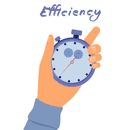3 Problems Scrum Fails to Resolve
Scrum provides a set of principles, values, and practices that lead to effective product management. However, Scrum still fails to solve some problems. Let's find out more about those problems in this guide.

Scrum is a powerful Agile framework that specifies roles, responsibilities, and events to complete a project from scratch. From product backlog creation and estimation to Sprint Planning, Daily Scrum, and Sprint Review/Retrospective, Scrum is a complete framework to handle all project activities. Besides that, cross-functional teams and continuous improvement loops further add to the credibility of Scrum.
All the core aspects of Scrum have made many teams and stakeholders assume that Scrum can handle all problems autonomously. But the truth is that Scrum also fails at some points. In this article, we will shed light on three major problems that Scrum fails to solve. So, let's head straight to our main discussion!
1. Not Enough Product Backlog Items
We know that the Product Owner is responsible for creating a product backlog based on the stakeholder requirements, market demands, etc. Besides that, the Product Owner also prioritizes the backlog items.
After a few Sprints, some teams may realize that they don't have enough product backlog items. For that, they might dedicate a few developers to work with the Product Owner to add the necessary items to the backlog or break down large items. So, the question is: Doesn't Scrum pinpoint the incomplete product backlog itself?
There is an assumption that Scrum teams do not need business requirements, as everything flows autonomously in Scrum. In traditional project management practices, teams often have a dedicated planning phase and an analysis/documentation phase where they write down all the requirements, even extending to dozens of pages. Once done, they will head for the development phase, knowing that they have all the requirements planned and documented.
In contrast, Scrum deals with changing requirements that emerge with time. That's why there is a product backlog refinement activity for the sole purpose of incorporating emerging requirements. So, Scrum does not require all requirements to be listed at the start and encourages a continuous upgrade model.
Now, let's see why Scrum teams struggle with the "not enough product backlog items" issue. During the project's early days, the Product Owner may find it challenging to add enough items to the Product Backlog.
The Product Owner might be unable to guess the team's Sprint Velocity, not size the items correctly, or struggle to determine main requirements. Besides that, the development team may also not detect the issue of too few product backlog items during the backlog estimation meeting, where they estimate the backlog items for the first time through Async Poker, Planning Poker, or any other technique.
After a few Sprints, the development team may point out the lack of enough items in the product backlog during the Sprint Review or Sprint Retrospective. Afterward, a few development team members can collaborate with the Product Owner to fix the issues of the product backlog.
In short, Scrum does not have an automated way to detect the lack of enough items in the product backlog. However, the beauty of Scrum is that its continuous feedback and review help to identify this problem timely.
2. Incomplete Stakeholder Communication
Another problem that Scrum fails to solve is incomplete or weak stakeholder communication. Oftentimes, the Product Owner struggles to finalize the product forecast (or roadmap) with the stakeholders. It is assumed that the Sprint Review meeting should address this matter, as it is when the team finalizes the next plans with the stakeholders.
Sprint Review is indeed a main event in Scrum that makes the Scrum team and stakeholders sit together and review the Sprint outcome. The stakeholders get the chance to present their feedback, go through the product backlog, and discuss the next Sprints with the team. Moreover, any new requests or changes from stakeholders are also entertained in this meeting.
In short, Sprint Review is beneficial for stakeholders to look into the Scrum team's progress and provide their feedback. So, why does the Product Owner still face incomplete or weak stakeholder communication?
Although Sprint Review looks like a complete meeting session that stakeholders need to communicate with the team, it still does not fulfill all the communication needs of stakeholders. For instance, the internal stakeholders might need a deeper discussion of the product forecast (or roadmap). Similarly, external stakeholders might ask for sales or marketing-related materials. Moreover, it is not possible to let all stakeholders attend the Sprint Review meeting. In fact, some Product Owners even invite only a few stakeholders to make it easy to communicate in the Sprint Review meeting.
Therefore, Scrum fails to resolve the issue of incomplete or weak stakeholder communication. It provides Sprint Review an opportunity to interact with stakeholders, but the team may need to conduct a few other meetings to discuss other matters with stakeholders.
3. Tackling Dependencies
Dependencies are common in product development, where the team has to wait to complete a specific piece of work unless the other work is completed first. Dependencies often slow down progress if they are not handled efficiently. Since Scrum makes the teams cross-functional (i.e., they possess the skills to deliver product increments every Sprint), it is assumed that dependencies will go away autonomously. However, the reality is different.
There are two types of dependencies that Scrum teams can face, i.e., internal or external. Internal dependencies are manageable much more easily, mainly during the Sprint Planning meetings. Alternatively, the Product Owner may reprioritize the backlog to address the dependencies effectively.
However, external dependencies are challenging. For instance, your team cannot complete the backlog item because the other team is working on the dependent work. Often, Scrum teams can manage external dependencies by reprioritizing the product backlog or improving the processes. But suppose the team frequently deals with dependencies. In that case, it should raise the matter in the Sprint Retrospective, identify the root causes, and try to implement measures to reduce dependencies in the future.
In short, Scrum does not directly assist in tackling internal and external dependencies. However, Scrum Teams can use Scrum events and product backlog refinement practices to mitigate dependencies.
Wrapping Up
Scrum is a popular and highly effective Agile framework used by tens of thousands of organizations to deliver quality products faster. However, Scrum teams should not consider Scrum an ultimate solution for all product development hurdles.
The great thing about Scrum is its ability to let the team know about the problem before it becomes a bigger concern. The Scrum framework is not like a strict, instructive framework to follow. It gives flexibility and allows the Scrum team to use their expertise and Scrum events to tackle almost all major complications. To sum up, teams can still face problems while using Scrum, but the problems are detectable early on and are manageable with the collaborative and adaptive nature of Scrum.




